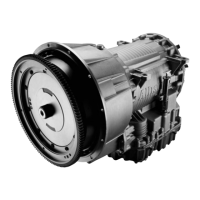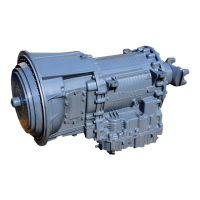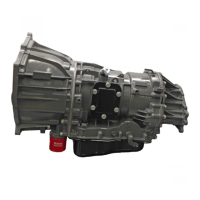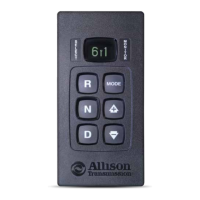6.Insertthedipstickintothelltube,pushingdownuntilitstops,butstillin
itslooseorunscrewedposition.
7.Removethedipstickandobservetheuidlevel.Iftheuidonthe
dipstickiswithintheCOLDCHECKband(refertoFigure5–1),thelevel
issatisfactory.Iftheuidlevelisnotwithinthisband,addordrain(refer
to5.7TRANSMISSIONFLUIDREFILLasnecessarytobringthelevel
withintheCOLDCHECKband.
8.PerformaHOTCHECKattherstopportunityafternormaloperating
temperature(71-93°C(160-199°F))isreached.
CAUTION:DONOToperatethetransmissionforextendedperiodsof
timeuntilaHOTCHECKhasveriedproperuidlevel.Transmission
damagecanresultfromextendedoperationatimproperuidlevel
conditions.
CAUTION:Theuidlevelrisesasuidtemperaturerises.DO
NOTllthetransmissionabovetheCOLDCHECKbandifthe
transmissionuidisbelownormaloperatingtemperatures.During
operation,anoverfulltransmissioncanbecomeoverheated,leading
totransmissiondamage.
CAUTION:Obtainanaccurateuidlevelbyimposingthefollowing
conditions:
•Engineisidling(500–800rpm)inN(Neutral)
•Transmissionuidisatthenormaloperatingtemperature
•Thevehicleisonalevelsurface
•Applytheparkingbrakeandchockthewheels
5.8.1.2HOTCHECKPROCEDURE
NOTE:Alwayscheckuidlevelwiththedipstickintheunscrewedor
looseposition.
TocompleteaHOTCHECKprocedureusingthedipstick,dothefollowing:
1.Besureuidhasreachednormaloperatingtemperatureof71-93°C
(160-200°F).Ifatransmissiontemperaturegaugeisnotpresent,
measureuidlevelwhentheenginewatertemperaturegaugehas
stabilized.
88
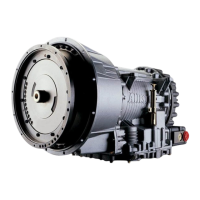
